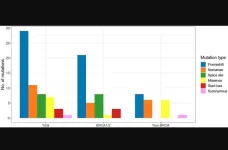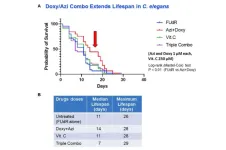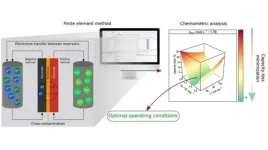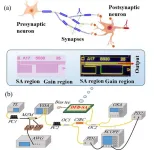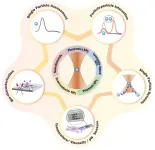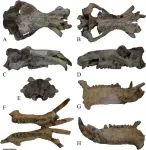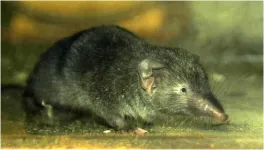(Press-News.org)
“Our study may reveal previously uncharacterized population-specific variants that may increase the risk of BC in the Kazakh population.”
BUFFALO, NY- November 22, 2023 – A new research paper was published in Oncotarget's Volume 14 on October 4, 2023, entitled, “Determination of genetic predisposition to early breast cancer in women of Kazakh ethnicity.”
Breast cancer (BC) is the most common type of cancer among women in Kazakhstan. To date, little data are available on the spectrum of genetic variation in Kazakh women with BC.
In this new study, researchers Gulnur Zhunussova, Nazgul Omarbayeva, Dilyara Kaidarova, Saltanat Abdikerim, Natalya Mit, Ilya Kisselev, Kanagat Yergali, Aigul Zhunussova, Tatyana Goncharova, Aliya Abdrakhmanova, and Leyla Djansugurova from the Institute of Genetics and Physiology, Kazakh Institute of Oncology and Radiology, Al-Farabi Kazakh National University, and Asfendiyarov Kazakh National Medical University aimed to identify population-specific genetic markers associated with the risk of developing early-onset BC and test their association with clinical and prognostic factors.
“To our knowledge, this is the first study using NGS [next-generation sequencing] technology to study the genetic predisposition to early-onset BC women from Kazakhstan and assess their impact on the patients’ clinical outcomes.”
The study included 224 Kazakh women diagnosed with BC (≤40 age). Entire coding regions (>1700 exons) and the flanking noncoding regions of 94 cancer-associated genes were sequenced from blood DNA using MiSeq platform. The researchers identified 38 unique pathogenic variants (PVs) in 13 different cancer-predisposing genes among 57 patients (25.4%), of which 6 variants were novel. In total, 12 of the 38 distinct PVs were detected recurrently, including BRCA1 c.5266dup, c.5278-2del, and c.2T>C, and BRCA2 c.9409dup and c.9253del that may be founder in this population. BRCA1 carriers were significantly more likely to develop triple-negative BC (OR = 6.61, 95% CI 2.44–17.91, p = 0.0002) and have family history of BC (OR = 3.17, 95% CI 1.14–8.76, p = 0.03) compared to non-carriers.
“This study allowed the identification of PVs specific to early-onset BC, which may be used as a foundation to develop regional expertise and diagnostic tools for early detection of BC in young Kazakh women.”
Read the full paper: DOI: https://doi.org/10.18632/oncotarget.28518
Correspondence to: Gulnur Zhunussova, Nazgul Omarbayeva
Emails: gulnur_j@outlook.com, nomarbayeva1@gmail.com
Keywords: early-onset breast cancer, triple negative breast cancer, next-generation sequencing, pathogenic variant, Kazakh population
About Oncotarget: Oncotarget (a primarily oncology-focused, peer-reviewed, open access journal) aims to maximize research impact through insightful peer-review; eliminate borders between specialties by linking different fields of oncology, cancer research and biomedical sciences; and foster application of basic and clinical science.
To learn more about Oncotarget, visit Oncotarget.com and connect with us on social media:
X, formerly known as Twitter
Facebook
YouTube
Instagram
LinkedIn
Pinterest
LabTube
Soundcloud
Sign up for free Altmetric alerts about this article: https://oncotarget.altmetric.com/details/email_updates?id=10.18632%2Foncotarget.28518
Click here to subscribe to Oncotarget publication updates.
For media inquiries, please contact: media@impactjournals.com.
Oncotarget Journal Office
6666 East Quaker Str., Suite 1A
Orchard Park, NY 14127
Phone: 1-800-922-0957 (option 2)
###
END
“Our ultimate goal is to find existing FDA-approved drugs and dietary supplements that can not only increase lifespan but also improve healthspan.”
BUFFALO, NY- November 22, 2023 – A new research paper was published in Aging (listed by MEDLINE/PubMed as "Aging (Albany NY)" and "Aging-US" by Web of Science) Volume 15, Issue 21, entitled, “Antibiotics that target mitochondria extend lifespan in C. elegans.”
Aging is a continuous degenerative process caused by a progressive decline of cell and tissue functions in an organism. It is induced by the accumulation of damage that affects normal cellular processes, ...
EMBARGOED FOR RELEASE UNTIL 4 P.M. ET, WEDNESDAY, NOVEMBER 22, 2022
MINNEAPOLIS – Black people who eat more foods with whole grains, including some breads and cereals, quinoa, and popcorn, may have a slower rate of memory decline compared to Black people who eat fewer whole grain foods, according to a study published in the November 22, 2023, online issue of Neurology®, the medical journal of the American Academy of Neurology. The researchers did not see a similar trend in white participants.
The study does not prove that eating more whole grains slows memory decline; it only shows an association.
The study found that among Black ...
An article by researchers at the Center for Development of Functional Materials (CDMF) in Brazil describes a successful strategy to mitigate charge capacity loss in vanadium redox flow batteries, which are used by electric power utilities among other industries and can accumulate large amounts of energy. The article is published in the Chemical Engineering Journal.
CDMF is a Research, Innovation and Dissemination Center (RIDC) funded by FAPESP and hosted by the Federal University of São Carlos (UFSCar) in São Paulo state.
The study involved computer ...
A new publication from Opto-Electronic Advances, 10.29026/oea.2023.230140 discusses photonic integrated neuro-synaptic core for convolutional spiking neural network.
Brain science and brain-like intelligence are the cutting-edge science and technology that countries all over the world compete to seize. The rapid rise and vigorous development of emerging fields such as artificial intelligence, 5G/6G, big data, autonomous driving, and the Internet of Things has led to the explosive growth of global data. Due to the memory wall effect, the conventional von Neumann architecture performs low energy efficiency. Electronic ...
A new publication from Opto-Electronic Science; DOI 10.29026/oes.2023.230021 overviews multi-synaptic photonic SNN based on a DFB-SA chip.
Compared with traditional artificial neural networks, spiking neural networks (SNN) are more biologically authentic, more powerful, and less power-consuming due to their spatiotemporal coding and event-driven characteristics. In recent years, optical computing has been widely considered as a hardware acceleration platform, where nonlinear computing poses a challenge. Photonic SNN provides an ultra-fast and energy-efficient platform for high-performance ...
A new publication from Opto-Electronic Science; DOI 10.29026/oes.2023.230019 overviews optical trapping of optical nanoparticles.
This article reviews the fundamentals and applications of optically trapped optical nanoparticles. Optical nanoparticles are nowadays one of the key elements of photonics. They do not only allow optical imaging of a plethora of systems (from cells to microelectronics), but also behave as highly sensitive remote sensors. In recent years, it has been demonstrated the success of optical tweezers in isolating and manipulating individual optical nanoparticles. This has opened the door to high resolution single particle scanning ...
The Iron Age site of Casas del Turuñuelo was used repeatedly for ritualized animal sacrifice, according to a multidisciplinary study published November 22, 2023 in the open-access journal PLOS ONE by Mª Pilar Iborra Eres of the Institut Valencià de Conservació, Restauració i Investigació, Spain, Sebastián Celestino Pérez of Consejo Superior de Investigaciones Científicas, Spain, and their colleagues.
Archaeological sites with evidence of major animal sacrifices are rarely ...
Modern hippos first dispersed in Europe during the Middle Pleistocene, according to a study published November 22, 2023 in the open-access journal PLOS ONE by Beniamino Mecozzi of the Sapienza University of Rome and colleagues.
Modern hippos, Hippopotamus amphibius, arose from African ancestors during the Quaternary, a time when hippos were widespread in Europe. However, the details of the modern species’ origin and dispersal into Europe are unclear and highly debated. In this study, Mecozzi and colleagues provide new insights via analysis of a fossil hippo skull from the study area of Tor di Quinto in Rome.
The skull of Tor di Quinto, currently housed at the ...
Status threat - the concern that outsiders will undermine your group's status - is associated with increased age, conservatism, conspiracy mentality, and paranoia, in study of 300 US adults
###
Article URL: https://journals.plos.org/plosone/article?id=10.1371/journal.pone.0293930
Article Title: Conspiracy mentality, subclinical paranoia, and political conservatism are associated with perceived status threat
Author Countries: USA
Funding: The authors received no specific funding for this work. END ...
Transplanting gut microbes from an obesity-resistant shrew can improve microbiome diversity and decrease the weight of obese mice
###
Article URL: https://journals.plos.org/plosone/article?id=10.1371/journal.pone.0293213
Article Title: Gut microbiota of Suncus murinus, a naturally obesity-resistant animal, improves the ecological diversity of the gut microbiota in high-fat-diet-induced obese mice
Author Countries: Japan, China
Funding: This work (PONE-D-23-21281) was supported by a Grant-in-Aid for Scientific Research from the ...
